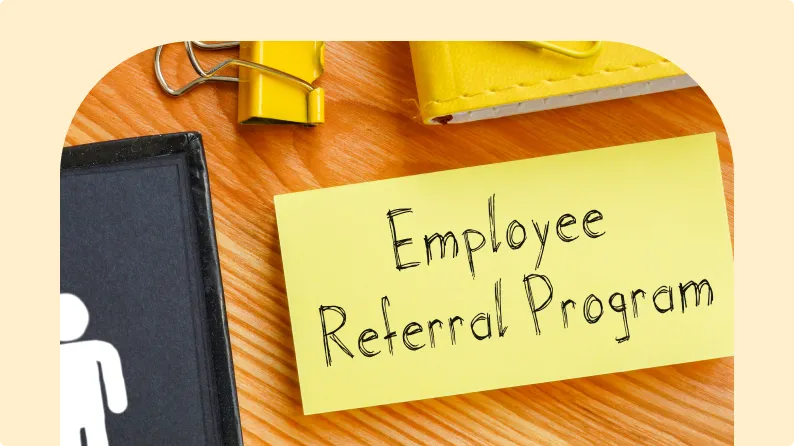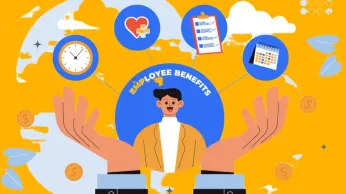How to Build a High-Impact Employee Referral Program to Atrract Top Talent
Discover how to create an employee referral program that attracts top talent, engages your workforce, and delivers high ROI. Includes tools, reward tips, and campaign ideas to help you scale your hiring with ease.
On this page
Most great hires come through people you already know, making employee referral programs so effective. When employees recommend someone from their network, they’re not just referring a resume; they’re vouching for that person’s skills, attitude, and cultural fit.
Hiring through referrals often leads to faster onboarding, better retention, and a stronger sense of team alignment. It also gives employees a meaningful way to contribute to the company’s growth and get rewarded for it. With the proper structure, a referral program can become a reliable engine for bringing in high-quality candidates.
To make the most of it, companies are turning to employee referral software that simplifies the process, automates rewards, and keeps employees engaged.
Whether starting from scratch or optimizing an existing program, this guide walks you through everything you need, from employee referral campaign ideas to examples and reward strategies.
What is meant employee referral program
An employee referral program is a structured initiative that encourages employees to recommend people from their personal or professional network for open roles in the company. It transforms team members into brand advocates, helping HR teams discover talent that might go unnoticed.
Unlike traditional recruiting methods, referrals are built on trust. When an employee puts forward someone they know, there's already a layer of credibility—both for the referrer and the referred candidate. It’s a practical approach that leverages existing connections to bring in people more likely to thrive in the company culture.
These programs typically involve a few key elements:
- Clear eligibility criteria for referrals
- A simple submission and tracking process
- Transparent communication about the status of referrals
- Defined employee referral program rewards to motivate participation
Well-executed referral programs create a sense of ownership and pride among employees while giving the recruitment process a significant boost in efficiency and effectiveness.
Benefits of a well-structured employee referral program
A thoughtfully designed employee referral program does more than fill job openings—it strengthens your workplace culture, improves retention, and enhances employee engagement. When employees are involved in hiring, they’re more invested in the outcome and the people joining their teams.
Here are some key benefits:
1. Faster hiring process
Referred candidates usually move through the hiring pipeline quicker. Since they're already pre-vetted by someone internal, they require fewer rounds of evaluation and often come with higher trust from hiring managers.
2. Higher retention rates
Employees hired through referrals tend to stay longer. They have a clearer understanding of the company culture and expectations thanks to insights shared by their referrer.
3. Better cultural fit
Employees recommend people they believe will work well with the team. This naturally results in hires who align better with the organization's values and working style.
4. Cost-effective recruitment
Referral hires reduce dependence on third-party recruitment agencies or expensive job ads. Plus, the return on investment from a successful hire far outweighs most employee referral program rewards.
5. Boosts employee engagement
When employees feel that their input in hiring is valued, it fosters a sense of ownership. Offering meaningful rewards for successful referrals further reinforces this engagement.
6. Encourages proactive talent sourcing
Instead of waiting for HR to reach out, employees begin thinking about people in their network who might be a great fit. This creates a steady pipeline of candidates for both current and future roles.
A robust program, primarily when powered by intuitive employee referral software, keeps everything transparent, automated, and easy to scale—making it a key part of any modern recruitment strategy.
Employee referral program examples
To understand what makes a referral program successful, it's helpful to look at real-life examples from companies that have turned their employees into powerful hiring allies. These organizations have gone beyond just offering bonuses—they’ve built engaging, easy-to-use programs that get results.
1. Salesforce
Salesforce launched a highly interactive employee referral campaign called “Friends of Salesforce,” where employees were encouraged to refer candidates by sharing a unique link. The campaign gamified the process by using leaderboards and special prizes for top referrers. The result? A massive spike in employee participation and referral-based hires.
2. Accenture
With thousands of positions to fill globally, Accenture built a fully digital employee referral program supported by intuitive software. Employees could track their referrals, view rewards progress, and access communication templates for outreach. They also offered double rewards for niche skill roles—helping fill specialized positions faster.
3. Google
Google’s program is famous for its simplicity and transparency. While the rewards are modest, they focus on speed and clarity: employees know when they’ll get paid and what roles are eligible. The company also sends reminders and updates through internal tools, keeping the momentum going.
4. Zappos
Zappos added a unique twist—if a referred employee stayed for more than 6 months, the referrer could choose between a cash reward or a donation to their favorite charity. This added an emotional element and aligned well with the company’s core values.
These examples show that an effective referral program isn't just about offering money—it's about clear communication, straightforward processes, and making employees feel like trusted partners in recruitment.
Modern solutions like employee referral software (including platforms like Empuls) offer templates, automation, and real-time dashboards to run campaigns like these with minimal admin effort.
Must-have features in employee referral software
You need more than just an email thread and a spreadsheet to scale and sustain a successful referral initiative. That’s where employee referral software becomes a game-changer. These platforms are designed to streamline the process for HR teams and make it incredibly easy for employees to participate, track, and get rewarded.
Here are the essential features to look for when choosing the right tool:
🧭 User-friendly interface
Employees are more likely to refer if the process is intuitive. The software should allow them to submit referrals in just a few clicks—via desktop, mobile, or integrated collaboration tools like Slack or MS Teams.
📊 Real-time tracking & transparency
Both employees and HR teams should be able to track the status of referrals. Transparency builds trust—employees want to know where their referral stands and when they’ll receive their reward.
📨 Automated communication workflows
Automated notifications, thank-you messages, interview updates, and reward alerts reduce manual tasks and keep everyone informed at every stage of the hiring journey.
🧩 Seamless ATS integration
The software should integrate easily with your Applicant Tracking System (ATS) to eliminate duplicate data entry and ensure referrals are processed like regular candidates.
🎯 Customizable campaigns
Look for platforms that let you run targeted employee referral campaigns—like seasonal drives, hard-to-fill role promotions, or diversity hiring pushes. Custom branding and messaging make campaigns feel more personalized and exciting.
🎁 Built-in rewards management
The best tools let you configure and automate employee referral program rewards—whether they’re monetary bonuses, gift cards, or experiences. Platforms like Empuls offer global catalogs, cost-of-living adjustments, and tax-compliant reward distribution across 100+ countries.
📈 Analytics and ROI reporting
Track metrics like referral-to-hire ratio, reward spend, campaign performance, and participation rates. Insights help refine your program and demonstrate its value to leadership.
Choosing the best employee referral software means investing in a solution that simplifies HR operations and delivers a seamless employee experience—turning occasional referrers into consistent contributors.
How to choose the best employee referral software
With so many platforms claiming to streamline referrals, finding your organization's best employee referral software requires a strategic approach. It’s not just about features—it’s about alignment with your culture, goals, and the scale of your hiring needs.

Here’s how to evaluate and select the right solution:
1. Assess ease of use for employees
The software should make referring someone as easy as sharing a link or uploading a resume. If employees feel it's complicated or time-consuming, participation will drop. Look for a clean, intuitive interface and mobile compatibility.
2. Evaluate admin controls & customization
HR teams should have the flexibility to:
- Create and manage campaigns,
- Customize workflows,
- Set eligibility rules,
- Approve or reject referrals easily.
Empuls, for instance, allows complete white-labeling—matching your brand colors, logos, and communication tone.
3. Check reward automation capabilities
Managing employee referral program rewards manually can be tedious. A great platform should:
- Automate reward distribution,
- Allow point-based or monetary incentives,
- Include a global catalog with gift cards, merchandise, and experiences.
Empuls supports localized reward delivery with multi-currency handling and taxation compliance.

4. Look for analytics & reporting tools
To measure success and fine-tune your efforts, your software must provide:
- Dashboards for tracking referral metrics,
- Reports on program performance,
- ROI insights showing cost-per-hire and retention data.
5. Ensure seamless integrations
Check compatibility with tools you already use—ATS (like Greenhouse, Lever), HRMS (like SAP, Darwinbox), or collaboration tools (like MS Teams, Slack). This reduces friction and ensures a smooth flow of information.
6. Consider support & onboarding help
Strong onboarding, training, and customer support can make or break your program's adoption. Top platforms offer implementation guidance, help center resources, and ongoing support.
When choosing a platform, think long-term. The best employee referral software isn’t just a tool—it becomes a core part of your hiring strategy. Solutions like Empuls go a step further by combining referrals with broader engagement tools like recognition, rewards, and communication—all on one platform.
Creative employee referral program ideas
A referral program doesn’t have to be another check-the-box initiative. The most successful programs feel exciting, rewarding, and inclusive. By tapping into creativity and tailoring your program to your company culture, you can transform it from a passive perk into a proactive, company-wide movement.
Here are several creative employee referral program ideas to elevate engagement and participation:
1. Make it fun with gamification
Turn referrals into a friendly competition. Introduce a point-based system where employees earn points for every step their referral clears—resume shortlisted, interview attended, offer accepted, and so on.
Display a live leaderboard on your internal platform or digital screens, and reward the top referrers at the end of each quarter. Gamification adds motivation, urgency, and fun to the program.
2. Offer double rewards for hard-to-fill roles
Some roles are more challenging to close than others, especially when niche skills are involved. Consider offering double the usual reward or bonus incentives with a deadline attached.
For example, "Refer a Data Engineer before May 15 and earn ₹50,000 instead of ₹25,000." Time-bound boosts help you fill roles faster while keeping things exciting for employees.
3. Launch theme-based referral campaigns
Give your employee referral campaign a personality. Try seasonal themes like "Spring into Talent," "Monsoon Mission: Refer & Earn," or "Winter Winners." Align the theme with branding, internal posters, emailers, Slack banners, and giveaways to bring energy and consistency across your communication channels.
4. Reward social sharing and outreach
Encourage employees to become advocates outside the company, too. Let them share job openings on their personal social media accounts. Reward them when a candidate is hired and even when a qualified lead applies or reaches the interview stage. This expands your reach and makes every effort feel valuable.
5. Add a surprise element with mystery rewards
Instead of listing the reward upfront, try teasing employees with a mystery reward campaign. Tell them every successful referral earns them something—but they’ll only find out after the candidate joins. The reward could be a smartwatch, a staycation, or a high-value gift card. The suspense can spark curiosity and encourage more referrals.
6. Celebrate together with team-based rewards
Make it a collective win. If someone refers a candidate who gets hired and completes their probation, reward the entire team with something experiential—like a team lunch, movie outing, or even a day trip. It encourages team collaboration and gives everyone a stake in building the team.
7. Showcase champions in a referral hall of fame
Recognition is just as robust as rewards. Create a “Referral Champions” wall on your intranet or digital signage that features top contributors each month. Share their stories, how many people they referred, and how it helped the team. This not only celebrates their effort but inspires others to participate.
8. Run a referral week every quarter
Dedicate one week every quarter to focus purely on referrals. Share hiring goals, highlight the most needed roles, bring in HR leaders for AMA sessions, run mini-contests, and keep daily updates rolling. Treat it like a campaign sprint. This gives your program fresh momentum and keeps it top-of-mind throughout the year.
All these ideas work even better when supported by the right tools. A platform like Empuls enables campaign creation, employee communications, reward tracking, and automated gift fulfillment—all from a single dashboard. Whether you're launching a short-term push or building a long-term strategy, creative ideas backed by reliable systems are key to success.
Structuring your employee referral program rewards
Rewarding employees for successful referrals is a fundamental part of any referral program, but how you structure those rewards can significantly influence participation and long-term engagement. It's not just about offering a payout; it's about making the reward feel meaningful, fair, and timely.
Here’s how to create a smart, motivating employee referral program rewards structure:
1. Define reward tiers based on role complexity
Not every referral is the same; your reward structure should reflect that. For example, you can offer different reward amounts based on the level or difficulty of the role:
- ₹5,000 for entry-level roles
- ₹15,000 for mid-level roles
- ₹25,000 or more for senior or specialized roles
This shows you recognize the extra effort it takes to find talent for complex positions and motivate employees to refer accordingly.
2. Offer a mix of monetary and non-monetary rewards
While cash bonuses are the most common incentive, non-monetary rewards can sometimes be more impactful. Consider options like:
- Premium gift cards
- Wellness experiences or spa vouchers
- Travel packages or staycations
- Personalized merchandise or company swag
- Exclusive perks like VIP parking, lunch with the CEO, or a paid day off

Platforms like Empuls offer an extensive global rewards catalog with over 1 million options, including gift cards, experiences, wellness packages, and merchandise—giving employees the freedom to choose what matters most.
3. Make the reward timeline clear
Transparency around when employees receive their reward is crucial. Typically, companies issue rewards once the referred candidate:
- Accepts the offer
- Completes the first 30, 60, or 90 days of employment
Communicate this upfront. Use your employee referral software to automate notifications and milestone reminders so employees aren’t confused about reward timelines.
4. Promote fairness and tax compliance
Ensure that your rewards are consistent across departments and locations. If your organization is global, consider adjusting rewards based on local cost of living or currency. Empuls, for instance, offers multi-currency and tax-compliant rewards, which ensures fairness and smooth financial processing across geographies.
5. Recognize the effort, even if the hire doesn’t happen
To keep morale high, you can consider micro-rewards or public appreciation for referrals that don’t result in a hire but meet specific criteria—such as reaching the final interview stage. This way, employees feel acknowledged for their contribution even if the outcome wasn’t successful.
A well-thought-out reward structure turns referrals into a habit, not just a one-time activity. The right combination of value, timing, and personalization ensures your program drives consistent participation and delivers actual recruitment results.
Launching an effective employee referral campaign
Even the most thoughtfully designed referral program needs the right launch strategy to gain traction. A well-executed employee referral campaign creates excitement, educates your workforce, and encourages participation immediately.
Here’s how to plan and launch a referral campaign that grabs attention and drives results:
1. Set clear goals and define success metrics
Before launching the campaign, identify what you’re aiming to achieve. Are you looking to fill specific roles quickly? Increase overall referral volume? Improve the quality of hire? Set measurable KPIs like:
- Number of referrals submitted
- Referral-to-hire conversion rate
- Time-to-fill reduction
- Participation rate across departments
This clarity helps you tailor your messaging and track the impact of your campaign.
2. Identify and promote priority roles
Not all job openings are equal. Use your referral campaign to spotlight high-priority or hard-to-fill positions. Share role summaries, ideal candidate personas, and what kind of experience you seek. The more context you provide, the better the matches you’ll receive.
You can use banners, targeted emails, Slack announcements, or your company’s social intranet—like the one offered by Empuls—to promote open roles company-wide.
3. Make it visual and engaging
Design campaign creatives with catchy taglines, eye-catching graphics, and a consistent visual theme. Think of internal posters, screen savers, email headers, or short videos. For example:
“Help us find our next rockstar! Refer & get rewarded.” “Know someone amazing? Bring them in, win big.”
Use bite-sized content formats and varied media like GIFs, quizzes, polls, or contests to keep employees involved throughout the campaign.
4. Communicate reward details upfront
Be transparent about the reward structure, payout timeline, and eligibility. A clear rewards breakdown builds trust and reduces confusion. You can also highlight success stories from past referrers—real employee testimonials go a long way in inspiring others to take action.
5. Automate and simplify the process
Make the referral process as easy as possible. Employees should be able to:
- Submit referrals in a few clicks
- Track progress and status
- Get notified when their referral moves forward
With a solution like Empuls, you can automate these touchpoints, schedule reminders, and keep everything organized under one dashboard.
6. Keep the energy alive throughout the campaign
Maintain momentum by sharing weekly updates, celebrating top contributors, and nudging inactive departments. Create mid-campaign boosts with flash rewards or surprise incentives. Use your internal comms to keep referrals top-of-mind.
A successful referral campaign is not a one-time email—it’s an ongoing experience. The right balance of clarity, motivation, and engagement ensures that your employee referral program doesn't just start strong but continues to deliver meaningful results over time.
Measuring the success of your referral program
Running an employee referral program is only half the job. To make it a long-term success, you must measure performance, identify gaps, and continuously improve.
Tracking the proper metrics helps you understand what's working, what needs adjustment, and how much value your referral program delivers to the business.
Here are the key metrics you should be monitoring:
📈 Referral-to-hire rate
This is the number of hires made through referrals compared to the total number of referrals submitted. A high rate indicates good-quality referrals and effective internal communication about the program. If the number is low, it may point to unclear role expectations or a misalignment in incentive structure.
⏱️ Time-to-fill for referred roles
Referrals often lead to faster hiring cycles. By comparing the time it takes to fill roles via referrals versus traditional methods, you can validate the speed advantage and push for greater adoption among hiring managers.
💰 Cost-per-hire savings
While costs are involved in employee referral program rewards, they are often significantly lower than recruiter fees or ad spends. Calculating cost-per-hire through referrals helps demonstrate clear financial ROI to leadership.
🤝 Participation rate
What percentage of your workforce is actively submitting referrals? High engagement suggests the process is simple and the rewards are compelling. If participation is low, it might be time to refresh your employee referral campaign approach or reintroduce the program with new ideas.
🧠 Quality of hire and retention rate
Track how long referred employees stay and how well they perform compared to those hired through other channels. High retention and performance among referred hires signal that employees are recommending candidates who are a strong fit for the company culture and role expectations.
📊 Campaign-specific insights
If you’ve launched themed campaigns or limited-time bonuses, evaluate their individual success:
- Did the campaign generate more referrals?
- Were the referrals aligned with the targeted roles?
- Which departments or teams were the most active?
Tools like Empuls offer built-in dashboards and analytics that let HR teams access real-time data on referrals, reward distribution, campaign engagement, and even ROI calculations. With these insights, you can optimize and scale your program with confidence.
Measuring success isn’t just about numbers—it’s about learning what drives employee behavior, where your bottlenecks are, and how you can better align your referral strategy with business outcomes.
Conclusion
A well-designed employee referral program is one of the most potent ways to bring in top talent. It fosters trust, boosts engagement, and taps into the networks your employees already have.
To make it work, you need more than just a rewards budget—structure, clarity, and the right tools. With modern employee referral software like Empuls, you can automate rewards, run engaging campaigns, and track results effortlessly.
Empower your team, recognize their contributions, and you’ll create a steady pipeline of quality hires who fit your culture from day one.















